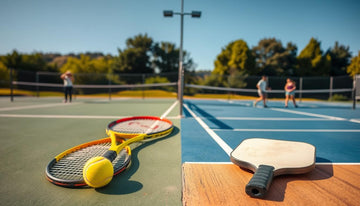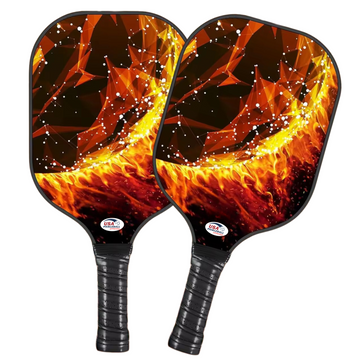Pickleball or Tennis: Which Sport is Right for You?
Are you looking for a new sport to try? Pickleball and tennis are two popular racquet sports that are gaining traction worldwide.
Both sports offer a great way to stay active, socialize, and have fun. They have distinct rules, equipment, and requirements. This article will provide a comprehensive comparison of pickleball and tennis. It will help you decide which sport suits your lifestyle and preferences.
Key Takeaways
-
Understand the basic rules and objectives of pickleball and tennis
-
Compare the equipment and court requirements for both sports
-
Learn about the physical demands and skill levels required for each sport
-
Discover the social benefits and community aspects of pickleball and tennis
-
Determine which sport is best suited for your lifestyle and preferences
Understanding the Basics of Pickleball and Tennis
Learning the game is easier when you're holding the paddle that feels just right
For beginners, knowing the basics of pickleball and tennis is key. Both sports are popular worldwide, attracting players of all ages. They offer different experiences based on your preferences and skill levels.
The Origins and Rise in Popularity
Pickleball was invented in 1965 by Joel Pritchard and his friends. It combines elements of badminton, tennis, and ping-pong. Created as a fun, family game, its popularity has soared with thousands of courts in the U.S.
Tennis, with roots in 12th century France, boasts a rich history. It's played globally, from amateur to professional levels.
https://www.youtube.com/watch?v=9ckxPu34c-Q
Basic Gameplay and Scoring Systems
In pickleball, players hit a plastic ball over a net with paddles. Games are played to 11 points. The scoring is simple, with points for the serving team when the opponent fails to return or makes an error.
Tennis involves hitting a ball over a net with a racket. Matches are divided into sets and games. Scoring is more complex, with points counted as 15, 30, 40, and then game.
Key Similarities and Differences at a Glance
Both pickleball and tennis require hand-eye coordination and strategy. Yet, they differ in equipment, court size, and gameplay. Pickleball courts are smaller than tennis courts, making it more accessible for some.
Understanding these key similarities and differences is crucial. It helps decide which sport to play.
Comparing Equipment and Court Requirements
Choosing between pickleball and tennis means looking at the gear and court needs. Each sport has its own special needs that can sway a player's decision.
Tennis Rackets vs. Pickleball Paddles
Tennis gear won’t cut it — the right pickleball paddle changes everything
Tennis rackets are longer and have strings for more power and spin. Pickleball paddles, on the other hand, are light and big, making them easier to handle.
Tennis rackets come in many sizes and weights, with pros often using custom ones. Pickleball paddles, though, are more uniform.
Court Dimensions and Accessibility
Tennis courts are bigger, at 78 feet long and 27 feet wide for singles, and 36 feet for doubles. Pickleball courts are 44 feet by 20 feet.
The smaller pickleball court is easier for beginners. It's less overwhelming than the big tennis court.
Budget Considerations for Beginners
For new players, the cost of gear and court time is key. Tennis rackets and balls are pricier than pickleball's.
|
Aspect |
Tennis |
Pickleball |
|
Equipment Cost |
Higher (Racket: $100-$300, Balls: $5-$10 per can) |
Lower (Paddle: $50-$150, Balls: $5-$10 per set of 6) |
|
Court Size |
Larger (78x27 feet for singles) |
Smaller (44x20 feet) |
|
Learning Curve |
Steeper due to the need for powerful serves and precise volleys |
Easier, with simpler rules and less demanding serves |
In the end, picking between pickleball and tennis depends on what you like, your budget, and what kind of experience you want.
Physical Demands and Health Benefits
Understanding the physical demands and health benefits of pickleball and tennis can help you decide which sport suits you best. Both sports offer a great way to stay active. They have different requirements and outcomes in terms of physical exertion and overall health impact.
Intensity Levels and Cardiovascular Impact
Pickleball and tennis vary in their intensity levels and cardiovascular impact. Tennis is generally considered a high-intensity sport. It requires quick movements and sustained periods of activity, significantly improving cardiovascular health. Pickleball, while also beneficial for cardiovascular health, tends to be less intense. This makes it more accessible to a wider range of players.
Tennis can improve cardiovascular health by increasing heart rate and blood flow during play. Pickleball, on the other hand, offers a more moderate intensity workout. It is still effective for improving heart health.
Joint Stress and Injury Prevention
Both sports have different impacts on the joints. Tennis involves a lot of running and quick changes of direction. This can put significant stress on the joints, mainly in the knees and ankles. Pickleball, being played on a smaller court with less running involved, tends to be easier on the joints.
To prevent injuries in both sports, proper warm-up routines and equipment are essential. For tennis, focusing on strengthening the muscles around the joints can also help mitigate the risk of injury.
Age and Fitness Level Considerations
Both pickleball and tennis can be adapted to different ages and fitness levels. Pickleball is often praised for its accessibility to older adults or those with mobility issues. Its less demanding nature makes it suitable for many. Tennis, while more physically demanding, can still be enjoyed by people of various fitness levels. This is true, even when played in a doubles format or with adapted rules.
Pickleball vs. Tennis: What's the Difference and Which is Right for You?
Choosing between pickleball and tennis depends on several factors. You should think about the learning curve, social aspects, and competitive levels of each sport. Both offer unique experiences that fit different tastes and goals.
Learning Curve: How Quickly Can You Become Proficient?
Pickleball is easier to pick up than tennis. It has simpler rules and doesn't need as much physical strength. Beginners can start playing pickleball in just a few hours. Tennis, on the other hand, requires more skill and fitness, taking longer to master.
Social Dynamics and Community Engagement
Both sports are great for meeting people, but in different ways. Pickleball is all about doubles, which brings players together. Tennis, while social, often focuses on singles, making it more competitive and personal.
Competitive Pathways and Tournament Structures
Tennis has a long history of professional tournaments, including the Grand Slams. Pickleball, though growing, has its own unique tournament structure and competitive paths.
Decision Framework: Matching the Sport to Your Goals
When deciding between pickleball and tennis, think about your goals, fitness, and what you enjoy. Use the table below to guide your choice:
|
Criteria |
Pickleball |
Tennis |
|
Learning Curve |
Easier to learn, quicker to start playing |
More challenging to learn, requires technique |
|
Social Dynamics |
Strong community, doubles-centric |
More individualistic, both singles and doubles |
|
Competitive Pathways |
Growing competitive scene |
Well-established professional circuit |
Getting Started: Step-by-Step Guide for Beginners
New to pickleball? It all starts with the right paddle — here's your step-by-step guide
New players in pickleball and tennis often wonder where to start. They want to enjoy their sport and do well. The path to becoming good involves simple steps.
Finding Local Courts and Instructors
Finding courts and instructors is the first step. Websites like Places2Play for pickleball and the ITF directory for tennis are great resources. Local community centers and sports clubs also offer classes and leagues for beginners.
Essential First Skills to Practice
Learning basic strokes is key for both pickleball and tennis. Start with serves, forehands, and backhands. Practice every day, even for a few minutes, to get better.
Recommended Starter Equipment
Choosing the right gear is important. Pickleball players need a good paddle and comfy shoes. Tennis players should pick a racket that fits their style and shoes for the court. Starter kits are a budget-friendly option.
Joining Leagues and Finding Playing Partners
After learning the basics, join leagues or find playing partners. Websites and apps like Meetup or local sports clubs help find other players. This makes the game more fun and helps you learn more.
|
Step |
Pickleball |
Tennis |
|
1. Find Courts & Instructors |
Places2Play, Local Community Centers |
ITF Directory, Local Tennis Clubs |
|
2. Practice Basic Strokes |
Serves, Forehands, Backhands |
Serves, Forehands, Backhands |
|
3. Equipment |
Pickleball Paddle, Comfortable Shoes |
Tennis Racket, Court Shoes |
|
4. Join Leagues/Find Partners |
Local Pickleball Leagues, Meetup |
Local Tennis Leagues, Tennis Clubs |
Ready to join a league? The right pickleball paddle is your first partner.
Conclusion
Choosing between pickleball and tennis depends on what you like, your fitness goals, and the community you want to join. Both sports have their own benefits and challenges. They appeal to different players in unique ways.
Think about the learning curve, physical demands, and social aspects when deciding. Pickleball is known for being easy to learn and having a strong social vibe. It's great for those who want to be part of a community.
Tennis, on the other hand, is famous for its competitive nature and physical challenge. It's perfect for those who love a good challenge and want to boost their heart health.
Your choice between pickleball and tennis should match your goals and preferences. If you're a beginner looking for fun or an athlete seeking competition, knowing the differences is key. Consider the equipment, court needs, and health perks of each sport. This will help you pick the best fit for your lifestyle and goals.
FAQ
What are the basic rules of pickleball?
Pickleball is simple. Players hit a plastic ball with a paddle. The goal is to make it land on the opponent's court in a way they can't return it. A game is played to 11 points, with a two-point lead needed to win.
How does the scoring system work in tennis?
Tennis scoring is a bit complex. A match is split into sets, and each set into games. A player wins a game by getting at least four points, unless it's tied at 40-40. Then, the game goes on until one player is two points ahead.A player must win at least six games to win a set. But, they need to win by two games.
Can I play pickleball or tennis if I'm not very fit?
Yes, both sports can be played by anyone, regardless of fitness. Pickleball is great for those who are less fit or older. It's played on a smaller court and requires less effort than tennis.
What kind of equipment do I need to start playing pickleball or tennis?
For pickleball, you need a paddle and a plastic ball. Tennis requires a racket and balls. Don't forget comfortable clothes and the right shoes for both sports.
Are there any age restrictions for playing pickleball or tennis?
No, there are no age limits for playing either sport. People of all ages can enjoy pickleball and tennis.
Can I play pickleball or tennis if I have a pre-existing injury?
Playing with an injury is possible, but first, talk to a doctor. They can say if it's safe and what precautions to take.
How long does it take to become proficient in pickleball or tennis?
Becoming good at either sport takes time. It depends on how often you play, the quality of your lessons, and your natural ability. Pickleball is easier to learn, with basic skills in a few weeks. Tennis might take longer.
Can I play pickleball or tennis competitively?
Yes, both sports have competitive scenes. You can join local, national, or international tournaments. There are leagues, ladder competitions, and sanctioned events for all skill levels.
How do I find local pickleball or tennis courts and instructors?
Look online or check with local sports centers to find courts and instructors. You can contact national governing bodies like the USA Pickleball Association or the United States Tennis Association (USTA).


